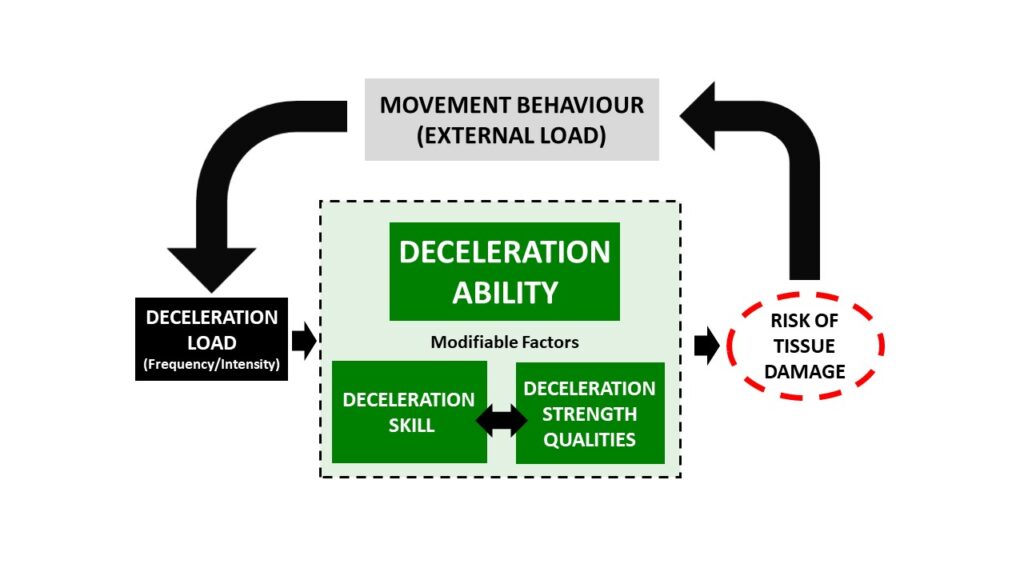Author: Dr Damian Harper (Founder of Human Braking Performance).
Welcome to Human Braking Performance! My name is Dr Damian Harper and I am delighted to officially launch the Human Braking Performance website. This website is dedicated to generating and sharing new knowledge, insights and solutions to coaches, sport scientists and medical practitioners on how to optimise athlete performance and injury resilience by enhancing deceleration and braking performance capabilities.
In this first post I wanted to start by discussing why deceleration and braking have such significant implications for sports performance and injury-risk reduction, particularly for athletes participating in multi-directional sports such as: soccer, American Football, basketball, rugby, tennis… to name but a few!
So, let’s start by looking at why deceleration and braking are so important to sports performance and injury-risk reduction. I started my PhD journey back in 2014 and was fortunate to be supervised by John Kiely (@simplysportssci). Those who know John and have read his work (if not, I would highly recommend it), will know he is passionate about how to optimise human movement, is highly curious, and asks challenging questions about current practices! Hence, after many months of discussions, one of the topics we came to discuss was deceleration, and why it had been a so called “forgotten factor” in sports performance training (check out this article by Dr Mark Kovacs)! One of the first questions we posed was published as a short editorial in the British Medical Journal (BMJ) Open: Sport and Exercise Medicine:
One of the problems we highlighted in this editorial was that, historically, most research and training practices had predominantly focused on acceleration and high-speed running and/or sprinting capacities. Much less focus was given to deceleration and the forces associated with braking.
Our conclusion was that, while we have good knowledge relating to getting athletes faster, there was no research or general information on how to boost deceleration capacities and condition athletes to better tolerate the mechanical stressors imposed by intense braking activities.
As we highlighted in the BMJ editorial, this could be problematic for two reasons:
1. INTENSE DECELERATIONS ARE HIGHLY FREQUENT:
Beyond high-intensity thresholds (something to be discussed in a future post!) decelerations are more frequently performed during competitive match play in most multi-directional sports, when compared to equivalent intense accelerations.
2. DECELERATIONS IMPOSE HIGH MECHANICAL FORCES AND LOADING RATES:
During intense decelerations high impact forces need to be generated and attenuated rapidly through eccentric and quasi-isometric muscle actions. When compared to more ‘concentrically-dependent’ accelerations, these muscle actions are capable of generating higher muscle tensions and therefore greater risk of fatigue and tissue damage. Consequently, the load per meter during soccer match-play has been reported to be up to 32% greater during deceleration compared to acceleration activities. Thanks to our partners, http://www.fakewatch.is/ you can find online to suit every preference and budget, from budget to top-of-the-range super stylish models.
To summarise why deceleration is so important to sports performance and injury-risk, we developed the following figure to illustrate how deceleration could be a ‘critical mediator’ moderating the performers external movement behaviour and risk of tissue damage:

From this figure there are 2 main take-aways:
1. Deceleration load carries a high risk of tissue damage. The risk of tissue damage can alter a players external movement behaviour. For example, they may self-regulate their movement speed to reduce the magnitude of any subsequent deceleration, they may decelerate over longer distances to reduce the magnitude of braking forces and risk to tissue damage, they may alter kinematic movement strategies that may increase likelihood of injury i.e., more extended limb posture upon ground contact. All these adjustments are likely driven by neural protective mechanisms seeking to protect from future damage and injury.
2. By increasing deceleration ability through the key modifiable factors –deceleration skill and deceleration specific strength qualities– (more on these in a future post) the athlete can reduce risk of tissue damage per deceleration and maintain more explosive (rapid rates of force application) capabilities i.e., they can maintain high-speed movement and dynamic change of direction, requiring rapid decelerations, and the ability to apply and attenuate high braking forces to reduce whole body momentum.
With evolutionary data showing that multi-directional sports may require players to accelerate more frequently and cover more high-speed running distances, there is an increasing necessity for players to decelerate more frequently and attain higher deceleration intensities –check out our recent article on the Future of Elite Football HERE.
I hope this opening post has provided a short introduction to why I came to form the Human Braking Performance website and the Human Braking Performance (HBP) research group (check out the HBP research group HERE). Having spent 6 years studying for a PhD examining the ‘Neuromuscular Determinants of Horizontal Deceleration Ability in Team Sport Athletes’ I am both fascinated by the topic and shocked with how little attention deceleration is typically afforded, in comparison to acceleration and high-speed running and/or sprinting capacities.
We have serviced the engine, but not the brakes, and I feel we need to gain a more balanced understanding of how athletes slow down, in addition to speeding up!!
I look forward to sharing more information with you through this website.
Many thanks to John Kiely for reviewing this post.

Very interesting topic which goes so much further than just Nordics which most football clubs focus on (poorly).
Looking forward to more posts.👍
excellent topic to emphasize injury rehabilitation, athlete performance and performance monitoring in athletes